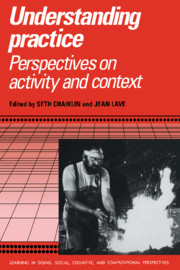Book contents
- Frontmatter
- Contents
- Series foreword
- List of contributors
- Part I Introduction
- Part II Learning craftwork
- Part III Learning as social production
- 8 Examinations reexamined: Certification of students or certification of knowledge?
- 9 Beneath the skin and between the ears: A case study in the politics of representation
- 10 The acquisition of a child by a learning disability
- 11 Context and scaffolding in developmental studies of mother–child problem-solving dyads
- 12 Solving everyday problems in the formal setting: An empirical study of the school as context for thought
- 13 Teacher's directives: The social construction of “literal meanings” and “real worlds” in classroom discourse
- Part IV Conclusion
- Author index
- Subject index
- Learning in Doing: Social, Cognitive, and Computational Perspectives
9 - Beneath the skin and between the ears: A case study in the politics of representation
Published online by Cambridge University Press: 06 January 2010
- Frontmatter
- Contents
- Series foreword
- List of contributors
- Part I Introduction
- Part II Learning craftwork
- Part III Learning as social production
- 8 Examinations reexamined: Certification of students or certification of knowledge?
- 9 Beneath the skin and between the ears: A case study in the politics of representation
- 10 The acquisition of a child by a learning disability
- 11 Context and scaffolding in developmental studies of mother–child problem-solving dyads
- 12 Solving everyday problems in the formal setting: An empirical study of the school as context for thought
- 13 Teacher's directives: The social construction of “literal meanings” and “real worlds” in classroom discourse
- Part IV Conclusion
- Author index
- Subject index
- Learning in Doing: Social, Cognitive, and Computational Perspectives
Summary
Constructing social facts: Clarity from ambiguity
Events in the world are ambiguous. We struggle to understand these events, to embue them with meaning. The choice of a particular way of representing events gives them a particular meaning. There is often a competition over the correct, appropriate, or preferred way of representing objects, events, or people. In fact, although there are many possible modes of representing the world and communicating them to people, the course of history can be envisioned as successive attempts to impose one mode of representation upon another.
Proponents of various positions in conflicts waged in and through discourse attempt to capture or dominate modes of representation. They do so in a variety of ways, including inviting or persuading others to join their side, or silencing opponents by attacking their positions. If successful, a hierarchy is formed, in which one mode of representing the world (its objects, events, people, etc.) gains primacy over others, transforming modes of representation from an array on a horizontal plane to a ranking on a vertical plane. This competition over the meaning of ambiguous events, people, and objects in the world has been called the “politics of representation” (Holquist, 1983; Shapiro, 1987; Mehan & Wills, 1988; Mehan, 1989).
For example, there are many ways in which nonresident laborers can be represented: “guest workers,” “potential citizens,” “illegal aliens,” “undocumented workers.” Each formulation or way of representing this group of people does not simply reflect its characteristics.
- Type
- Chapter
- Information
- Understanding PracticePerspectives on Activity and Context, pp. 241 - 268Publisher: Cambridge University PressPrint publication year: 1993
- 111
- Cited by



